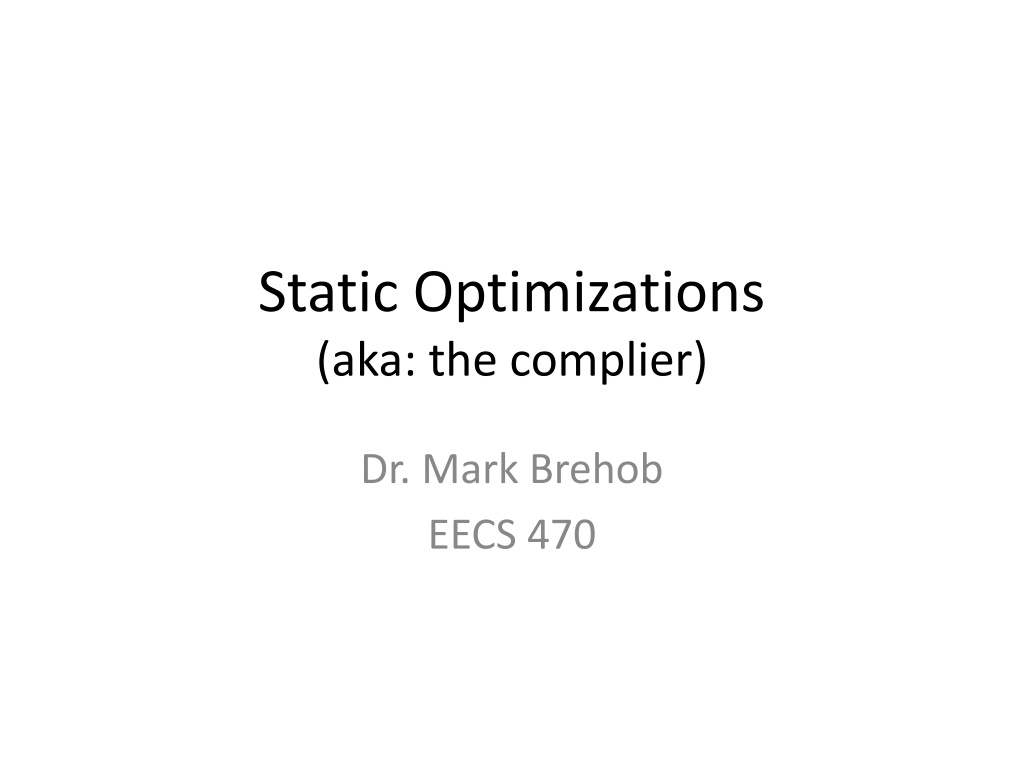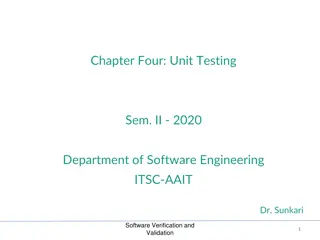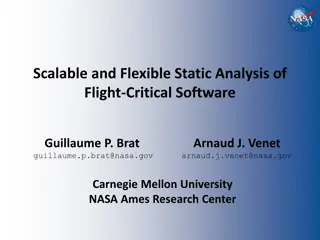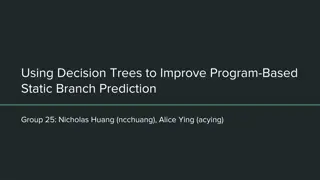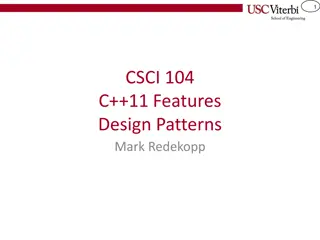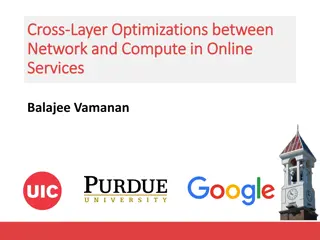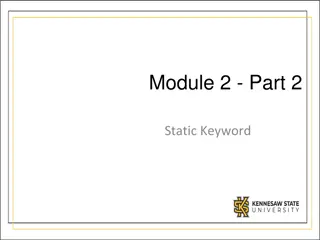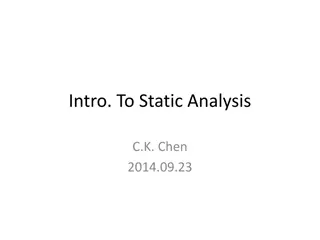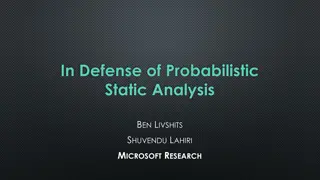Static Optimizations
Explore the fundamental concepts of static optimizations in hardware architecture, focusing on compiler-driven techniques to improve performance and efficiency. Learn how compilers can enhance data locality, reduce unnecessary instructions, and minimize branches executed. Discover strategies such as improving reference locality, register optimization, code removal, and branch reduction. Gain insights into hoisting loads for latency hiding and achieving hardware-software synergy.
Download Presentation

Please find below an Image/Link to download the presentation.
The content on the website is provided AS IS for your information and personal use only. It may not be sold, licensed, or shared on other websites without obtaining consent from the author.If you encounter any issues during the download, it is possible that the publisher has removed the file from their server.
You are allowed to download the files provided on this website for personal or commercial use, subject to the condition that they are used lawfully. All files are the property of their respective owners.
The content on the website is provided AS IS for your information and personal use only. It may not be sold, licensed, or shared on other websites without obtaining consent from the author.
E N D
Presentation Transcript
Static Optimizations (aka: the complier) Dr. Mark Brehob EECS 470
Announcements Quiz Tuesday 4/2 Coverage the same as the last homework Or maybe a bit from earlier
The big picture We ve spent a lot of time learning about dynamic optimizations Finding ways to improve ILP in hardware Out-of-order execution Branch prediction But what can be done statically (at compile time)? As hardware architects it behooves us to understand this. Partly so we are aware what things software is likely to be better at. But partly so we can find ways to find hardware/software synergy
Some ways a compiler can help Improve locality of data Remove instructions that aren t needed Reduce number of branches executed Many others
Improve locality of reference o Examples: o Loop interchange flip inner and outer loops for i from 0 to 10 for j from 0 to 20 a[j,i] = i + j for j from 0 to 20 for i from 0 to 10 a[j,i] = i + j o Loop fission split into multiple loops Some examples taken from Wikipedia
Removing code (1/2) Register optimization Registers are fast, and doing spills and fills is slow. So keep the data likely to be used next in registers. Loop invariant code motion Move recomputed statements outside of the loop. for (int i=0; i<n; i++) { x = y+z; a[i] = 6*i+x*x; } x = y+z; for (int i=0; i<n; i++) { a[i] = 6*i+x*x; }
Removing code (2/2) Common sub-expression elimination (a + b) - (a + b)/4 Just compute a+b once. Constant folding Replace (3+5) with 8.
Reducing number of branches executed Using predicates or CMOVs instead of short branches Loop unrolling for(i=0;i<10000;i++) { A[i]=B[i]+C[i]; } for(i=0;i<10000;i=i+2) { A[i]=B[i]+C[i]; A[i+1]=B[i+1]+C[i+1]; }
Well mostly focus on one thing Hoist loads That is move the loads up so if there is a miss we can hide that latency. Very similar goal to our OoO processor. xxxxx xxxxx LD R1=MEM[x] R2=R1+R3 LD R1=MEM[x] xxxxx xxxxx R2=R1+R3
What limits our ability to hoist a load? ________________________________________ _________________________________________ _________________________________________
Create room to move code around Loop unrolling The idea is to take a loop (usually a short loop) and do two or more iterations in a single loop body. for i=1 to 5000 { for i=1 to 10000 { Loop body Initial Loop body } Loop body } Glue logic
Unroll this loop for(i=0;i<10000;i++) { A[i]=B[i]+C[i]; n+=A[i]; } Glue logic? Reduce operations? Glue logic? Reduce operations?
What does unrolling buy us? Reduces number of branches Reduces number of branches Less to (mis-)predict If not predicting branches (say cheap embedded processor) very helpful! If limited number of branches allowed in ROB at a time, reduces this problem. Can schedule for pipeline better If superscalar might be best to combine certain operations. Loop unrolling adds flexibility
What does it cost us? Code space. Mainly worried about impact on I-cache hit rate. But L2 or DRAM impact if unroll too much! If loop body has branches in it can hurt branch prediction performance. Other?
Another one to unroll. for(i=0;i<99999;i++) { A[i]=B[i]+C[i]; B[i+1]=C[i]+D[i]; }
One more to do while (B[i]!=0) { i++; A[i]=B[i]+C[i]; B[i+1]=C[i]+D[i]; }
How about this code? Loop: r1=MEM[r2+0] r1=r1*2 MEM[r2+0]=r1 r2=r2+4 bne r2 r3 Loop We ll come back to this later
Other ILP techniques Consider an in-order superscalar processor executing the following code: R1=16 //A R2=R1+5 //B R3=14 //C R4=R3+5 //D Without OoO we would execute A, BC, D. Note that A&B are independent of C&D. So ordering ACBD would let us do AC, BD. Thus, the simple action of reordering instructions can increase ILP.
So We can expose ILP by Unrolling loops Reordering code To increase # of independent instructions near each other To move a load (or other high-latency instruction) from its use. What limits reordering options?
The limits of hoisting loads (again) Moving code outside of its basic block is scary In other words, moving code past branches or branch targets can give wrong execution Loads or stores might go to invalid locations Need to be sure don t trash a needed register. Also Moving loads past stores is scary What if store wrote to that address The problem is that we don t have the recovery mechanisms we do in hardware After all, the program specifies behavior! How do we know when the specified behavior is wrong ? In hardware it is fairly easy
Static dependency checking A superscalar processor has to do certain dependency checking at issue (or dispatch) Is a given set of instructions dependent on each other? If ALU resources are shared are there enough resources? Many of these issues can be resolved at compile time. What can t be resolved? Once resolved, how do you tell the CPU?
One static solution: VLIW Have a bunch of pipelines, usually with different functional units. Each instruction actually contains directions for all the pipelines. (Thus the very long instruction ) Pipe1 int Pipe2 int Pipe3 fp Pipe4 ld/st Pipe5 branch VLIW Instruction word
Whats good about VLIW? Compiler does all dependency checking, including structural hazards! No dependence checking makes the hardware a lot simpler! Reduces mis-prediction penalty. Saves power May save area! Since the compiler can also reorder instructions we may be able to make good use of the pipes.
So whats bad? Code density If you can t fill a given pipe, need a no-op. To get the ILP needed to be able to fill the pipe, often need to unroll loops. When a newer processor comes out, 100% compatibility is hard Word length may need to change Structural dependencies may be different
Conditional execution r8=cmp(r1,r2) if(r8) r4=r5 + r6 r7=r4+r12 Conditional execution (we ve done this before!) bne r1 r2 skip r4=r5+r6 skip: r7=r4+r12 -or- r8=cmp(r1,r2) r9=r5+r6 cmov (r8, r4 r9) r7=r4+r12
Code example from before Loop: r1=MEM[r2+0] r1=r1*2 MEM[r2+0]=r1 r2=r2+4 bne r2 r3 Loop And one name dependency on r2. Also the store is dependent on r2 but hidden
ILP? Currently no two instructions can be executed in parallel on a statically scheduled machine. (With branch prediction A and E could be executed in parallel) On a dynamically scheduled machine could execute instructions from different iterations at once. r1=MEM[r2+0] r1=r1*2 MEM[r2+0]=r1 r2=r2+4 bne r2 r3 Loop //A //B //C //D //E
What would OoO do? r1=MEM[r2+0] //A r1=r1*2 //B MEM[r2+0]=r1 r2=r2+4 bne r2 r3 Loop A perfect, dynamically scheduled, speculative computer would find the following: //C //D //E A1 B1 C1 C2 .. D1 A2 B2 B3 .. D2 A3 A4 .. E1 D3 D4 .. E2 E3 .. Let A1 indicate the execution of A in the first iteration of the loop.
Software Pipeline r1=MEM[r2+0] //A r1=r1*2 //B MEM[r2+0]=r1 //C r2=r2+4 //D bne r2 r3 Loop With software pipelining we can do the same thing in software. MEM[r2+0]=r1 r1=r4*2 r4=MEM[r2+8] //A(n+2) r2=r2+4 bne r2 r3 Loop //E //C(n) //B(n+1) What problems could arise? Speculative load might cause an exception. //D(n) //E(n) Latency of load could be too slow.
Prolog and epilog r3=r3-8 // Needed to check legal! r4=MEM[r2+0] //A(1) r1=r4*2 //B(1) r4=MEM[r2+4] //A(2) Loop: MEM[r2+0]=r1 r1=r4*2 r4=MEM[r2+8] r2=r2+4 bne r2 r3 Loop MEM[r2+0]=r1 r1=r4*2 MEM[r2+0]=r1 r3=r3+8 //C(n) //B(n+1) //A(n+2) //D(n) //E(n) // C(x-1) // B(x) // C(x) // Could have used tmp var.
Software Pipelining example Execution Code Layout Action Flow Stage A iter1 II iter0 Prologue Stage B Stage A Stage C Stage B Stage A Kernel Stage D Stage C Stage B Stage A Stage D Stage C Stage B Epilogue Stage C itern-2 Stage C Stage D itern-1
Example, just to be sure. r4=MEM[r2+0] r1=r4*2 r4=MEM[r2+4] MEM[r2+0]=r1 r1=r4*2 //B(n+1) r4=MEM[r2+8] //A(n+2) r2=r2+4 bne r2 r3 Loop //A1 //B1 //A2 //C(n) ADDR 12 16 20 24 DATA 55 23 19 -5 Loop: //D(n) //E(n) R2=12, r3=28 R4=_______ R1= _______
Next step r1=MEM[r2+0] //A r1=r1*2 //B MEM[r2+0]=r1 //C r2=r2+4 //D bne r2 r3 Loop Parallel execution It isn t clear how D and E of any iteration can be executed in parallel on a statically scheduled machine What if load latency is too long? Will be stalling a lot Fix by unrolling loop some. //E
NEXT Let s now jump from Software Pipelining to IA- 64. We will come back to Software Pipelining in the context of IA-64 We will redo the IA-64 stuff from the start for next lecture Not sure how far I ll get into it today.
IA-64 128 64-bit registers Use a register window similarish to SPARC 128 82 bit fp registers 64 1 bit predicate registers 8 64-bit branch target registers
Explicit Parallelism Groups Instructions which could be executed in parallel if hardware resources available. Bundle Code format. 3 instructions fit into a 128-bit bundle. 5 bits of template, 41*3 bits of instruction. Template specifies what execution units each instruction requires.
Instructions 41 bits 4 high order specify opcode (combined with template for bundle) 6 low order bits specify predicate register number. Every instruction is predicated! Also NaT bits are used to handle speculated exceptions.
Speculative Load Load instruction (ld.s) can be moved outside of a basic block even if branch target is not known Speculative loads does not produce exception - it sets the NaT Check instruction (chk.s) will jump to fix- up code if NaT is set Traditional IA-64
Propagation of NaT Only single check required NaT[reg] = NaT bit of reg IF ( NaT[r3] || NaT[r4] ) THEN set NaT[r6] IF ( NaT[r6] ) THEN set NaT[r5] Require check on NaT[r5] only since the NaT is inherited Reduce number of checks Fix-up will execute the entire chain
Advanced loads ld.a Advanced load Performs the load, puts it into the ALAT If any following store writes to the same address, this is noted with a single bit. When a ld.c is executed, if that bit is set, we refetch. When chk.a is executed, if bit is set, fix up code is run. (Useful if load result already used.) Both also cause any deferred exception to occur.
Software pipelining on IA-64 Lots of tricks Rotating registers Special counters Often don t need Prologue and Epilog. Special counters and prediction lets us only execute those instructions we need to.
